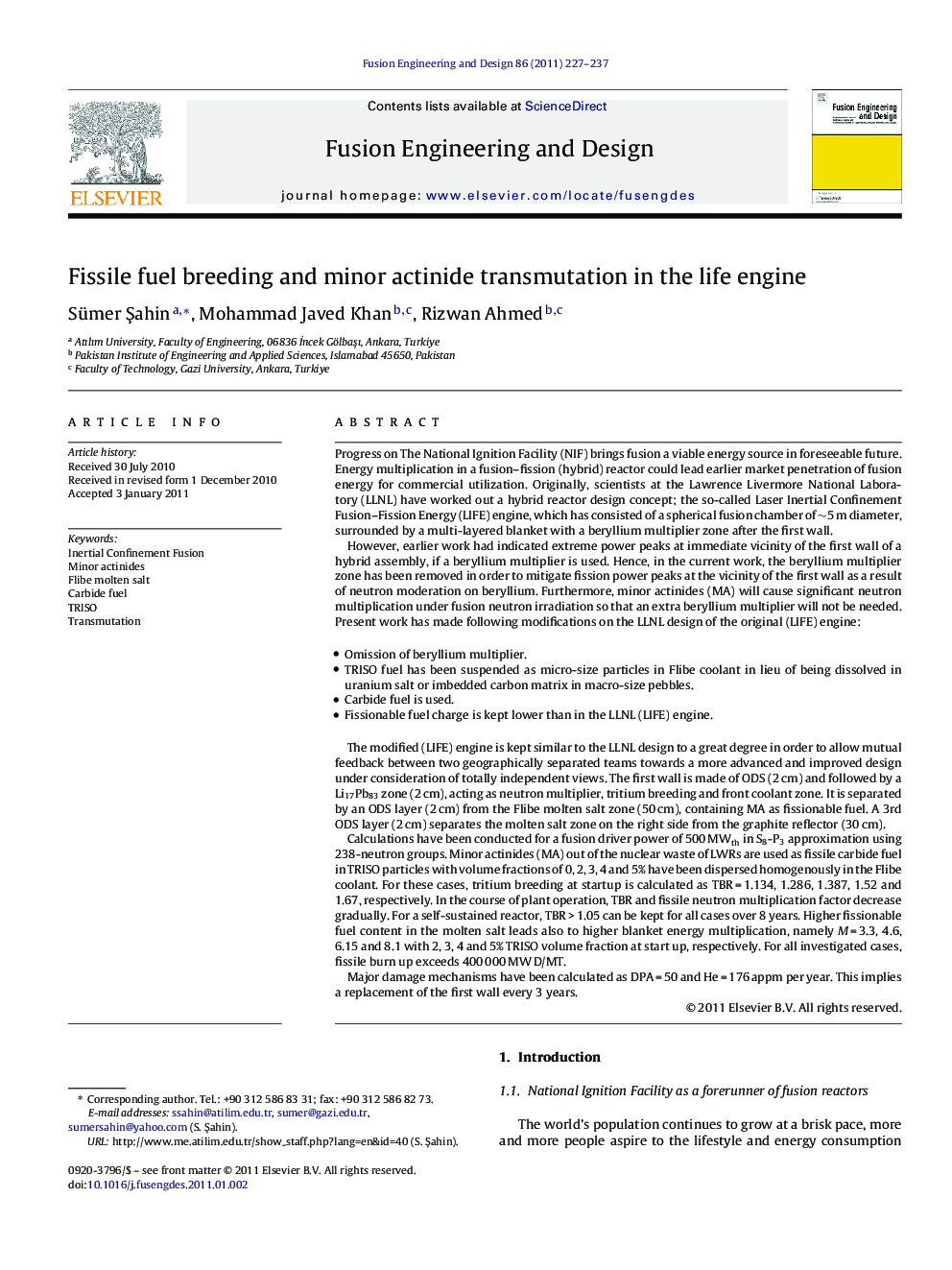| کد مقاله | کد نشریه | سال انتشار | مقاله انگلیسی | نسخه تمام متن |
|---|---|---|---|---|
| 272584 | 505026 | 2011 | 11 صفحه PDF | دانلود رایگان |

Progress on The National Ignition Facility (NIF) brings fusion a viable energy source in foreseeable future. Energy multiplication in a fusion–fission (hybrid) reactor could lead earlier market penetration of fusion energy for commercial utilization. Originally, scientists at the Lawrence Livermore National Laboratory (LLNL) have worked out a hybrid reactor design concept; the so-called Laser Inertial Confinement Fusion–Fission Energy (LIFE) engine, which has consisted of a spherical fusion chamber of ∼5 m diameter, surrounded by a multi-layered blanket with a beryllium multiplier zone after the first wall.However, earlier work had indicated extreme power peaks at immediate vicinity of the first wall of a hybrid assembly, if a beryllium multiplier is used. Hence, in the current work, the beryllium multiplier zone has been removed in order to mitigate fission power peaks at the vicinity of the first wall as a result of neutron moderation on beryllium. Furthermore, minor actinides (MA) will cause significant neutron multiplication under fusion neutron irradiation so that an extra beryllium multiplier will not be needed. Present work has made following modifications on the LLNL design of the original (LIFE) engine:
• Omission of beryllium multiplier.
• TRISO fuel has been suspended as micro-size particles in Flibe coolant in lieu of being dissolved in uranium salt or imbedded carbon matrix in macro-size pebbles.
• Carbide fuel is used.
• Fissionable fuel charge is kept lower than in the LLNL (LIFE) engine.The modified (LIFE) engine is kept similar to the LLNL design to a great degree in order to allow mutual feedback between two geographically separated teams towards a more advanced and improved design under consideration of totally independent views. The first wall is made of ODS (2 cm) and followed by a Li17Pb83 zone (2 cm), acting as neutron multiplier, tritium breeding and front coolant zone. It is separated by an ODS layer (2 cm) from the Flibe molten salt zone (50 cm), containing MA as fissionable fuel. A 3rd ODS layer (2 cm) separates the molten salt zone on the right side from the graphite reflector (30 cm).Calculations have been conducted for a fusion driver power of 500 MWth in S8-P3 approximation using 238-neutron groups. Minor actinides (MA) out of the nuclear waste of LWRs are used as fissile carbide fuel in TRISO particles with volume fractions of 0, 2, 3, 4 and 5% have been dispersed homogenously in the Flibe coolant. For these cases, tritium breeding at startup is calculated as TBR = 1.134, 1.286, 1.387, 1.52 and 1.67, respectively. In the course of plant operation, TBR and fissile neutron multiplication factor decrease gradually. For a self-sustained reactor, TBR > 1.05 can be kept for all cases over 8 years. Higher fissionable fuel content in the molten salt leads also to higher blanket energy multiplication, namely M = 3.3, 4.6, 6.15 and 8.1 with 2, 3, 4 and 5% TRISO volume fraction at start up, respectively. For all investigated cases, fissile burn up exceeds 400 000 MW D/MT.Major damage mechanisms have been calculated as DPA = 50 and He = 176 appm per year. This implies a replacement of the first wall every 3 years.
Journal: Fusion Engineering and Design - Volume 86, Issues 2–3, March 2011, Pages 227–237